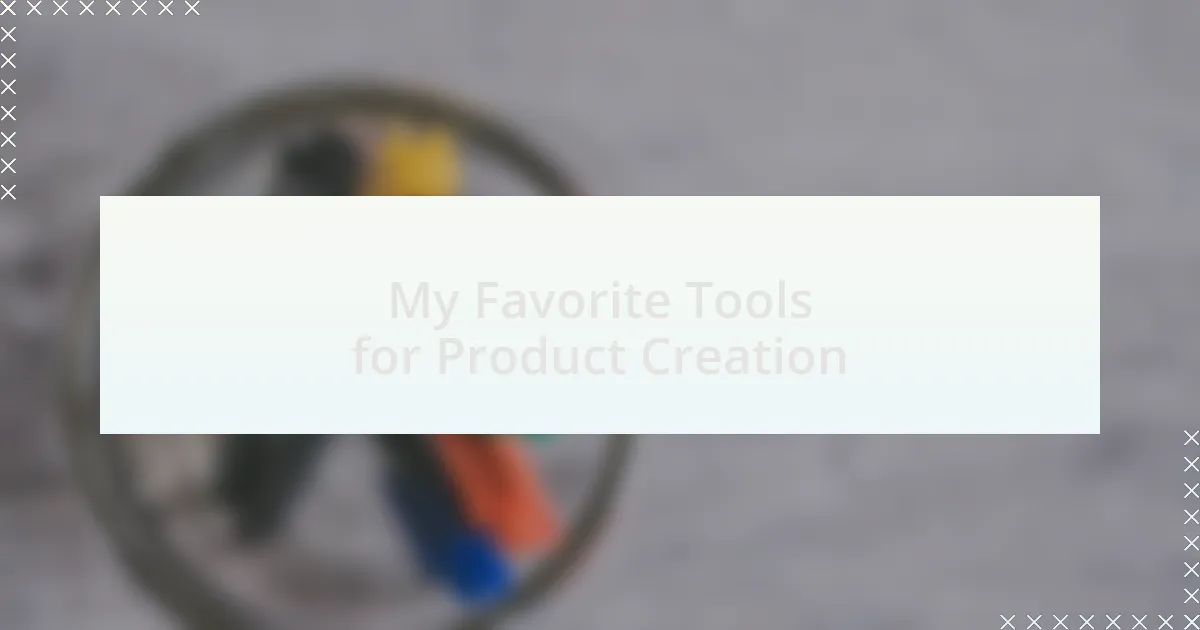Key takeaways:
- Product creation tools transform ideas into tangible products, enhancing creativity and collaboration.
- Prototyping and project management tools, such as Figma and Trello, streamline the design process and improve task prioritization.
- Communication and feedback tools like Slack and Google Forms facilitate effective collaboration and user-centered design improvements.
Author: Oliver Bancroft
Bio: Oliver Bancroft is an accomplished author and storyteller known for his vivid narratives and intricate character development. With a background in literature and creative writing, Oliver’s work often explores themes of human resilience and the complexities of modern life. His debut novel, “Whispers of the Forgotten,” received critical acclaim and was nominated for several literary awards. In addition to his fiction, Oliver contributes essays and articles to various literary magazines. When he’s not writing, he enjoys hiking and exploring the great outdoors with his dog, Max. Oliver resides in Portland, Oregon.
Introduction to Product Creation Tools
In the ever-evolving landscape of product creation, tools serve as our best allies. They help streamline the myriad tasks that can feel overwhelming at times. Have you ever felt stuck trying to transform an idea into a tangible product? The right tools can bridge that gap and make the process feel not just achievable but exciting.
I remember the first time I used a prototyping tool; it was like a light bulb turned on. Suddenly, I could visualize my ideas in ways I hadn’t imagined. These tools provide a unique combination of simplicity and sophistication, allowing us to experiment without the pressure of perfection. Isn’t that a freeing experience?
Moreover, product creation tools can be the secret ingredient that elevates our work from good to great. They offer us the chance to collaborate effectively, gather feedback, and refine our creations. What if you could transform a half-baked concept into a polished product overnight? With the right toolkit, this can very well become a reality.
Overview of Design Tools Available
When it comes to design tools, the variety available is both exciting and overwhelming. From graphic design software like Adobe Illustrator to prototyping tools such as Figma or Sketch, each serves unique purposes that cater to different stages of the design process. I personally find navigating this sea of options invigorating, as each tool carries its own charm and capabilities.
Let’s not forget about the collaborative platforms. Tools such as Miro or Notion offer dynamic spaces for brainstorming and gathering insights with team members, which I’ve found incredibly helpful when working on larger projects. Have you ever noticed how a shared digital canvas can spark creativity? It transforms solitary work into a collaborative adventure, breathing fresh life into concepts that might have otherwise stalled.
On the more technical side, there are tools focused on technical design, like CAD software for product modeling. My first experience with CAD was a bit daunting, yet thrilling—the precision it offered was unlike anything I had experienced before. Each click felt powerful, as if I were shaping my ideas into reality, and it made me realize the importance of choosing tools that resonate with my own creative process. What tools resonate with you?
Essential Tools for Product Design
When diving into product design, I’ve come to rely heavily on prototyping tools like Figma and InVision. The first time I created an interactive prototype, I felt like a magician—watching a static design come to life was simply exhilarating. Have you ever experienced that rush of excitement when your ideas begin to take shape in a tangible way? It can transform your workflow, making it easier to communicate your vision to clients or team members.
Equally important are the tools that focus on project management, such as Trello or Jira. I remember struggling with project timelines early in my career, but once I integrated these tools, everything changed. Suddenly, I was not just a designer but also a strategist, able to visualize the entire process. This shift helped me prioritize tasks better and maintain focus on what truly matters.
Let’s not overlook the significance of user testing tools like UserTesting or Maze. My first usability test left me a bit nervous—will users understand my design? The insights the feedback provided were invaluable and refined my approach immensely. Engaging with actual users can feel daunting, but it’s a step that brings clarity and encourages the kind of iterative improvement that every designer needs. What insights have your user tests revealed?
Tools for Collaboration and Feedback
Communication is key in collaboration, and tools like Slack or Microsoft Teams have become staples in my workflow. I still remember the first time I set up a team channel to discuss a project; it felt like opening up a direct line to a world of ideas. Isn’t it amazing how being able to share quick thoughts or files can lead to spontaneous brainstorming sessions? Those moments of synergy are where some of the best ideas emerge.
Another tool that I can’t recommend enough is Miro. I was initially skeptical about using an online whiteboard, but it transformed the way my team and I brainstorm. Picture this: group members from various locations contributing to a visual map of ideas in real-time. The energy was contagious, and I found myself discovering connections I hadn’t considered before. Have you ever noticed how visuals can simplify complex thoughts? It’s a game-changer.
Feedback tools such as Google Forms or Typeform also play a crucial role in my design process. One memorable experience involved sending out a survey after a project launch, and the responses were insightful. They revealed gaps in user experience that I hadn’t even anticipated. How often do we assume our designs are perfect until users guide us toward improvements? Embracing constructive feedback has not only enhanced my projects but also deepened my understanding of user needs.

Leave a Reply